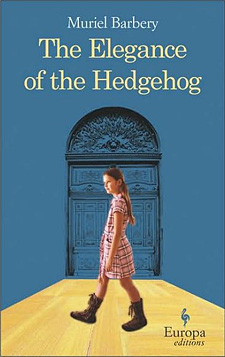 Renee is a concierge and widow, who hides behind the persona of low-class domestic servant to protect her livelihood. There is a secret from her past that has taught her that one should not rise above one's station in life.
Renee is a concierge and widow, who hides behind the persona of low-class domestic servant to protect her livelihood. There is a secret from her past that has taught her that one should not rise above one's station in life.
Pamona is a 12-year-old with a brilliant sister, a depressed mother and a politician father who does not feel like she fits in and nor is she appreciated. She is actually planning to suicide on her 13th birthday. She lives in the same apartment block.
Eventually the two of them connect and become friends, over their mutual appreciation of the new Japanese tenant, who can see who each truly is.
Where does the hedgehog fit in? Pamona calls Renee a hedgehog, which sounds a bit harsh, but is actually meant as a compliment! She sees that on the outside, Renee has constructed a fortress, harsh quills; but on the inside, she is soft and terribly elegant! In fact it is the theme of the book, the false versus true self.
This is one of those books where you dog-ear several pages and you read out the quotes to anyone who will listen.
"¢ There are musings on the nature of time. How important it is to be in the moment; and how wasteful it is to carry the baggage of the past or the burdens of tomorrow.
"¢ There are musings on the beauty that is all around us: a perfectly formed camellia, a droplet of water, the way being in a choir dissolves our differences.
"¢ There are musings on the beauty inside each person; we might call it the image of God. There is wonder on the inside, as well as the outside.
Pamona also has "Profound Thoughts" which she journals. No. 15 is:
If you want to heal
Heal others
And smile or weep
At this happy reversal of fate
The writing is simply beautiful. Muriel Barbery has a wonderful way of describing scenes that make you able to see, hear, smell, touch, and/or taste it. It is a very sensual book. Since then I have discovered she is a photographer, and so has an eye for shape and form and detail, and an ability to capture a moment in time.
Ms Barbery is also a philosophy teacher, and the book is full of ideas of meaning in life. Most of the people are looking in the wrong places: in class, in work, in chemical avoidance, in self obsession"
In the end, the author upholds beauty and truth and freedom, as the great definers of meaning and purpose. Then in the development of the story, love enters as a major force.
There are weaknesses in the book. Sometimes, ironically, Renee goes on so much about the pretentiousness of others that she sometimes sounds a little pretentious herself; thankfully, she is down to earth enough that she can appreciate both Japanese art and Hunt for Red October, Kant and the crime writer Michael Connelly.
However, my biggest criticism is that she fails to engage with God or Jesus. She dismisses religion, without examining the person of Jesus, as appeasing our "animal fears and the unbearable prospect that some day all our pleasures will cease". I fear she has confused religion with God. In the end she counsels against searching for the divine or the eternal: "from now on I'll be searching for those moments of always within never. Beauty, in this world."
The book has been a bestseller in France, but there are some doubts about its popularity here. Firstly, I suspect that we are less well-versed in philosophy and speculation on life than the French, so some of the reflections of Renee and Pamona may seem too abstract.
Secondly, the ending has a twist. It is not a Hollywood ending by any means. However, I think that the ending is a strength also, because this is not a cutesy, old widow rediscovers love, bit of puff pastry. It is more gritty and real, like life.
In spite of the weaknesses, I found this book very satisfying. It is so beautifully written, it shines with its reflections on the stuff of everyday life, and the main characters are beautifully drawn. It is a delight.
To see some of Muriel Barbery's photographs that inspired, or were inspired by the book, click here to visit her website.













